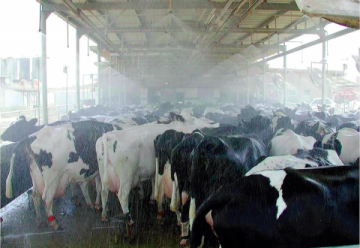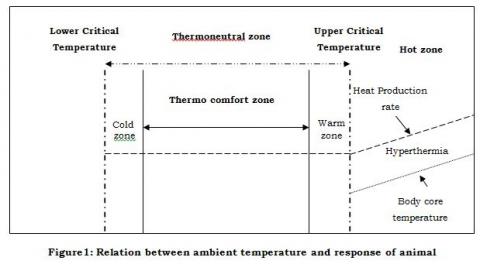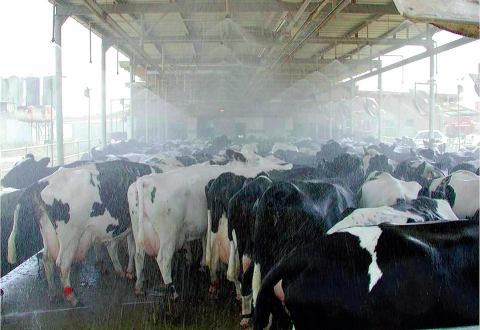
Managing Heat Stress in Dairy animals: Practical approaches
What is heat stress?
Heat Stress indicates all high temperature related stress, which induces thermoregulatory changes in cattle. During the extreme hot humid or hot dry weather, this thermoregulatory capability of cattle to dissipate heat by sweating and panting is compromised and heat stress occurs. Severe heat stress can further lead to rise in body temperature, increased pulse rate, increased peripheral blood flow, reduced feed intake, and increased water intake.

When the environmental temperature goes beyond Upper critical temperature (24°-26°C for Exotic and crossbred cattle and 33°C for Zebu cattle and 36°C for buffaloes), body is unable to maintain the core body temperature through sweating and panting (evaporative heat loss mechanism). This when coupled with rising body heat production rate lead to hyperthermia in the animal (Figure 1).
Economic importance:
All the changes associated with heat stress lead to loss of productivity, reduced breeding efficiency and even loss of life in extreme cases. Every year in India severe loss in milk production incurred due to heat stress causing huge financial loss. Heat stress has also detrimental effects on reproduction by decreasing oestrus expression, conception rate and by increasing length of service and dry period.
Susceptible animals:
Though indigenous breeds of cattle are more thermo-tolerant, crossbred and exotic breeds of cattle are highly sensitive to heat stress. Buffaloes are more prone to this owing to their black skin that absorbs more solar radiations and fewer sweat glands (only 1/6th that of cattle), compromising heat dissipation through evaporative heat loss.
When is it most stressful?
|
Part of India |
Comfortable months |
Stressful months |
|
Northern Part |
November-February |
May-September |
|
Western Part |
December-January |
May-September |
|
Southern Part |
November-February |
April-September |
|
Eastern Part |
November-February |
April-October |
Detecting Heat stress through symptoms:
In case of heat stress, the following symptoms are seen
· Rapid and weak pulse
· Rapid but shallow breathing
· Abnormal vital parameters: Elevated heart rate, respiration rate, rectal temperature etc.
· Unusual salivation
· Dizziness / unconsciousness
· Skin becomes dull and may be cold too
· In case of heat stroke, body temperature is very high– sometimes as high as 106 – 108°F.
Managing Heat stress:
The following factors are important in managing thermal stress
· Ensure that the animals are kept under shades. The most effective source of shade is trees. If shade trees are not available, thatched roof of a minimum height of 9 feet should be provided. Agri-nets with 20% perforation are also useful. If facilities are not available with the individual farmers, facilities available at the village shall be used by the community.
· Thatching the roof with materials like paddy straw etc, painting the roof with white paint or, providing a false ceiling insulation will help provide a cooler environment.
· Create barriers against hot wind using thatched wall or wet gunny cloth/ gunny bags.
· Ensure one ventilator of 3 x 1 feet per cow in covered shed. In these sheds heavy duty fan is best option to facilitate ventilation.
· Misting/Fogging of water in the microenvironment of the animal at least thrice in an hour along with provision of fan is useful in hot dry weather. Auto Mister/ Fugger with mini pumps and cyclic timers are preferable.
· Heat stress can also be managed by spraying/ sprinkling water directly on the body of animalsfor a period of 1 to 5 minutes at an interval of 10- 30 minutes. Fans/ blowers should be used to induce evaporation from the skin of animals. With a provision of fan this method can work both in hot dry and hot humid condition.
· The most effective way of combating heat stress in buffalo is wallowing in the water pond.

Figure 2: Animal cooling systems are very important especially in high yielding crossbreds and exotic animals
· Ensure adequate round the clock drinking water to animals, which should be provided under shade.
· Feeding should be practiced during early morning, evening &night.
· Prefer grazing during early morning & late evening hours to avoid the scorching heat.
· Ration density may be increased so as to provide same nutrients at reduced dry matter intake. Diets with low-fibre and high fermentable carbohydrate have lower dietary heat increment compared to high fibre diets.
· Ensure increased mineral supplementation during hot weather to meet the increased demand of minerals. Potassium rich mineral mixture should be preferred.
Treatment:
Immediate veterinary aid should be provided to the suffering animal. In the meantime, the animal shall be moved to a cooler place, given bath with cold water or wrapped in wet sheets and provided with fan.
